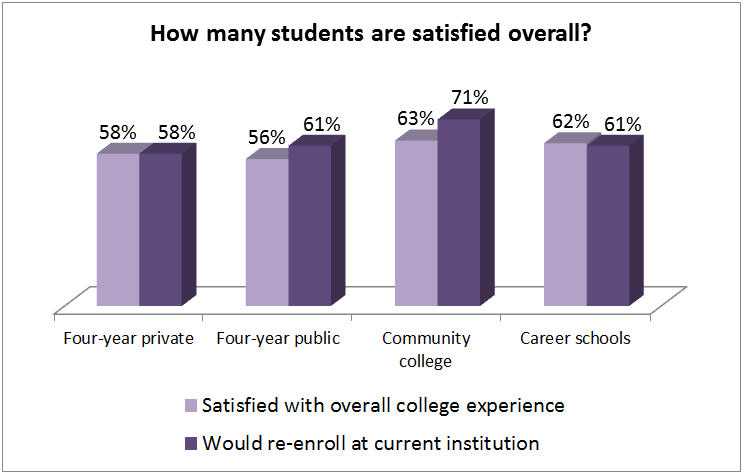student success
Do college students think tuition is a worthwhile investment? Findings from the new national student satisfaction report
As the cost of attending college has increased over the previous decade, there has been more scrutiny about whether the investment in a college education is worthwhile. New data from the 2014 National Satisfaction and Priorities Report shows that half of students at four-year institutions show dissatisfaction in this area.
The report features responses from nearly 600,000 students at 728 institutions nationwide that administered the Student Satisfaction Inventory™ (SSI) between the fall of 2011 and the spring of 2014. The majority of students responded that they were satisfied with their overall college experience and that they would probably re-enroll at their campuses if they had to do their college experiences all over again. These results have remained steady or slightly improved for all four sectors compared to a year ago.

While the majority of students indicate they are satisfied with their experiences, there are still many areas where there is room for improvement on the national level, including satisfaction with tuition. The report looks at student satisfaction for the statement, “Tuition paid is a worthwhile investment.” As the table below shows, only half of students at four-year institutions expressed satisfaction with this item.

The percentages in red indicate that this item is a challenge (an area of high importance and low satisfaction) to four-year privates, four-year publics, and career schools, while the percentages in green indicate this item is a strength (high importance and high satisfaction) at community colleges. Four-year private institutions in particular showed a large gap between performance and satisfaction, the third highest gap of any survey item across all institution types. Four-year public institutions also did not perform well here.
What can you do to improve the perception of your tuition being a worthwhile investment for your students? For four-year institutions, it’s important to be more aware than ever of what the “sticker shock” attendance costs may pose to students, as well as the growing concern of student debt to attend college. Get out in front of these concerns, not only for recruiting prospective students, but also promoting persistence among current students. Consider strategies such as:
- Tracking and publishing employment outcomes for graduates.
- Tracking and publishing graduate/professional school placement rates for undergraduates at four-year institutions or transfer rates for two-year college students to four-year institutions.
- Inviting alumni on campus to share their successes in person.
- Using social media to highlight student successes, educational quality, and other value.
- Conducting price sensitivity research to assess how students feel about your cost to attend
This is just one area the National Student Satisfaction and Priorities Report examines. It also looks at topics such as:
- Financial aid and tuition payment options
- Faculty interactions and timely feedback
- Access to classes
- Campus safety
- Overall campus climate
The report provides an analysis of the relevant scores in each area and offers suggestions for ways campuses can improve student satisfaction in these critical areas. I invite you to read the full report and to take a look at the addendum specific to your institution type to be aware of national satisfaction levels.
Why does college student satisfaction assessment matter?
Every day, college students make value judgments not just about their overall educational experience, but the elements that contribute to it. Financial aid policies, academic advising, the ability to register for classes, faculty interaction, campus climate and culture – these and many other factors contribute to overall student satisfaction. Furthermore, as I shared in a previous blog, recent research from Noel-Levitz suggests that schools with higher graduation levels also have higher student satisfaction levels.
Campuses that conduct regular satisfaction assessments are able to track student priorities, identify challenges, and improve the quality of student life and learning. Of the campuses we are working with that are regularly surveying students with our satisfaction-priorities assessments, 63 percent are reporting improved retention and 37 percent of them credit their satisfaction assessment activities as contributing to this improvement.
Are you conducting satisfaction assessment on your campus? How satisfied are your students as compared with the national benchmarks? Do you know the priority areas for improvement based on your students’ perceptions of their experience? I would be happy to talk with you about conducting a satisfaction assessment on your campus. Email me about what you would like to learn about the satisfaction and priorities of your students, and I can suggest strategies for tracking these important metrics.
